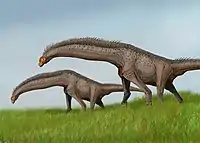| Lameta Formation | |
|---|---|
| Stratigraphic range: Maastrichtian ~ | |
 Exposure of the Lameta Formation at its type locality of Lameta | |
| Type | Geological formation |
| Underlies | Intertrappean Beds, Deccan Traps deposits |
| Overlies | Jabalpur Group or Precambrian Basement |
| Area | 5,000 km2 (1,900 sq mi) |
| Thickness | Variable, typically 18–45 m (59–148 ft) |
| Lithology | |
| Primary | Claystone, sandstone limestone |
| Other | Conglomerate |
| Location | |
| Coordinates | 23°12′N 80°00′E / 23.2°N 80.0°E |
| Approximate paleocoordinates | 24°42′S 63°12′E / 24.7°S 63.2°E |
| Region | Western India |
| Country | |
| Extent | Madhya Pradesh, Gujarat, Maharashtra, Andhra Pradesh, Telangana |
| Type section | |
| Named for | Lameta Ghat |
 Lameta Formation (India) | |
The Lameta Formation, also known as the Infratrappean Beds (not to be confused with the contemporaneous Intertrappean Beds), is a sedimentary geological formation found in Madhya Pradesh, Gujarat, Maharashtra, Telangana, and Andhra Pradesh, India, associated with the Deccan Traps.[1] It is of Maastrichtian age (Late Cretaceous), and is notable for its dinosaur fossils. Many dubious names have been created for isolated bones, but several genera of dinosaurs from these rocks are well-supported, including the titanosaur sauropod Isisaurus and the abelisaurs Indosaurus, Indosuchus, Laevisuchus, and Rajasaurus.[2] As well as mammals, snakes and other fossils.
Lithology
The formation is underlain by the Lower Cretaceous sedimentary "Upper Gondwana Sequence" also known as the Jabalpur Formation, and is overlain by the Deccan Traps basalt. The Lameta Formation is only exposed at the surface as small isolated outcrops associated with the Satpura Fault. The lithology of the formation, depending on the outcrop, consists of alternating clay, siltstone and sandstone facies, deposited in fluvial and lacustrine conditions. The environment at the time of deposition has alternatively been considered semi-arid, or tropical humid.[3][4]
Fossil content
Dinosaurs


- Sauropod
| Genus | Species | Location | Stratigraphic position | Material | Notes | Images |
|---|---|---|---|---|---|---|
| Isisaurus | I. colberti | Dongargaon Hill | A titanosaur. |  | ||
| Jainosaurus | J. septentrionalis | Bara Simla | "Basicranium and partial postcranial skeleton."[5] | A titanosaur. |  | |
| Titanosaurus | T. blanfordi | "Caudal vertebrae."[6] | ||||
| T. indicus | "Teeth"[7] | |||||
- Theropod
| Genus | Species | Location | Stratigraphic position | Material | Notes | Images |
|---|---|---|---|---|---|---|
| Indosaurus | I. matleyi | Bara Simla | Partial skeleton, including a partial skull.[8] | |||
| Brachypodosaurus | B. gravis | "Humerus."[9] | ||||
| Coeluroides | C. largus | Bara Simla | "Isolated vertebrae."[10] | |||
| Dryptosauroides | D. grandis | Bara Simla | "Vertebrae."[10] | |||
| Indosuchus | I. raptorius | Bara Simla | Cranial remains, including two braincases, as well as a nearly complete skeleton.[8] | An Abelisaurid theropod. |  | |
| Jubbulpuria | J. tenuis | "Vertebrae."[10] | ||||
| Lametasaurus | L. indicus | Bara Simla | "Sacrum, ilia, tibia."[10] "Sacrum, ilia, tibia, spines, armor."[11] | |||
| Laevisuchus | L. indicus | Bara Simla | Only vertebrae.[8] | |||
| Ornithomimoides | O. barasimlensis | Bara Simla | "Vertebrae."[10] | |||
| O. mobilis | Bara Simla | "Vertebrae"[10] | ||||
| Orthogoniosaurus | O. matleyi | Bara Simla | "Tooth"[10] | |||
| Rahiolisaurus | R. gujaratensis | Rahioli Village | An Abelisaurid theropod. |  | ||
| Rajasaurus | R. narmadensis | Temple Hill, Rahioli | An Abelisaurid theropod. |  |
Reptile
Snakes
| Genus | Species | Location | Stratigraphic position | Material | Notes | Images |
|---|---|---|---|---|---|---|
| Sanajeh | S. indicus | A skull, precloaca vertebrae and ribs. | A madtsoiid snake |  Sanajeh about to attack a titanosaur hatchling | ||
| Madtsoia | M. pisdurensis[12] | A madtsoiid snake | ||||
Turtles
| Genus | Species | Location | Stratigraphic position | Material | Notes | Images |
|---|---|---|---|---|---|---|
| Jainemys | J. pisdurensis | A bothremydid side-necked turtle | ||||
See also
- List of dinosaur-bearing rock formations
- Geology of India
- Deccan Traps
- Maevarano Formation, contemporaneous fossiliferous formation of Madagascar
- Intertrappean Beds contemporaneous formation in India, also known for its fossils
References
- ↑ Wilson Mantilla, Gregory P.; Renne, Paul R.; Samant, Bandana; Mohabey, Dhananjay M.; Dhobale, Anup; Tholt, Andrew J.; Tobin, Thomas S.; Widdowson, Mike; Anantharaman, S.; Dassarma, Dilip Chandra; Wilson Mantilla, Jeffrey A. (2022-04-01). "New mammals from the Naskal intertrappean site and the age of India's earliest eutherians". Palaeogeography, Palaeoclimatology, Palaeoecology. 591: 110857. doi:10.1016/j.palaeo.2022.110857. ISSN 0031-0182.
- ↑ Weishampel et al., 2004, pp.517-606
- ↑ Srivastava, Ashok K.; Mankar, Rupesh S. (January 2015). "Lithofacies architecture and depositional environment of Late Cretaceous Lameta Formation, central India". Arabian Journal of Geosciences. 8 (1): 207–226. doi:10.1007/s12517-013-1192-y. ISSN 1866-7511. S2CID 67851941.
- ↑ Kumari, Anjali; Singh, Seema; Khosla, Ashu (January 2021). "Palaeosols and palaeoclimate reconstruction of the Maastrichtian Lameta Formation, Central India". Cretaceous Research. 117: 104632. Bibcode:2021CrRes.11704632K. doi:10.1016/j.cretres.2020.104632. S2CID 224946979.
- ↑ "Table 13.1," in Weishampel, et al. (2004). Page 269.
- ↑ "Table 13.1," in Weishampel, et al. (2004). Page 270.
- ↑ "Table 13.1," in Weishampel, et al. (2004). Page 271.
- 1 2 3 "Table 3.1," in Weishampel, et al. (2004). Page 49.
- ↑ "Table 17.1," in Weishampel, et al. (2004). Page 367.
- 1 2 3 4 5 6 7 "Table 3.1," in Weishampel, et al. (2004). Page 50.
- ↑ "Table 17.1," in Weishampel, et al. (2004). Page 368.
- ↑ Mohabey, D.M.; Head, J.J.; Wilson, J.A. (2011). "A new species of the snake Madtsoia from the Upper Cretaceous of India and its paleobiogeographic implications". Journal of Vertebrate Paleontology. 31 (3): 588–595. Bibcode:2011JVPal..31..588M. doi:10.1080/02724634.2011.560220. S2CID 129792355.
Bibliography
- Weishampel, David B.; Peter Dodson, and Halszka Osmólska (eds.). 2004. The Dinosauria, 2nd edition, 1–880. Berkeley: University of California Press. Accessed 2019-02-21. ISBN 0-520-24209-2